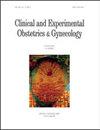Identification and characteristics of drug resistance and genotypes of methicillin-resistant Staphylococcus aureus isolated from intensive care units at obstetrics & gynaecology departments: a retrospective analysis
IF 0.6
4区 医学
Q4 OBSTETRICS & GYNECOLOGY
引用次数: 0
Abstract
Background: The aim of this study was to investigate the prevalence and characteristics of SCCmec genotypes and drug resistance of methicillin-resistant Staphylococcus aureus (MRSA) isolated from intensive care units (ICU) at obstetrics & gynaecology departments in a tertiary hospital. Methods: MRSA obtained from patients admitted to the ICU were isolated and identified by using the Vitek 2 Compact System with GP21 342 cards. Antimicrobial susceptibility profiles and MRSA screening were determined by using the broth microdilution method according to CLSI guidelines. Determination of resistant genes and SCCmec genotypes were performed by multiplex PCR. Results: Of the 283 patients evaluated, 120 (42.4%) isolates were phenotypically and genotypically confirmed to be MRSA. Among 120 strains, 15 (12.5%) strains were SCCmec type II, 96 (80%) strains were SCCmec type III and 9 (7.5%) strains were undifferentiated type. All MRSA strains were recognized as multidrug resistant, exhibiting 100% resistance to cefoxitin and oxacillin, followed by erythromycin and levofloxacin (more than 80% and 90% respectively). Different SCCmec genotypes in MRAS isolates showed distinct antimicrobial agent patterns. SCCmec type II was highly resistant to clindamycin (93.3%) with lower resistance to tetracycline (26.7%) with SCCmec type III being highly resistant to gentamicin (91.7%). Undifferentiated strains were resistant to Cotrimoxazole (77.8%). There was a statistical difference among type II, type III and Undifferentiated strains (P < 0.05). Of interest, a high prevalence of resistance to rifampicin (more than 75%) was also noted in the hospital. With different SCCmec genotypes, MRSA isolates were sensitive to minocycline, quinupristin, teicoplanin, vancomycin and nitrofurantoin. Conclusions: Our data indicate that SCCmec type II and SCCmec type III of MRSA are circulating in the ICU and constitute a major source for the infection spread. It is necessary to increase surveillance of MRSA in the ICU and develop adequate infection prevention strategies.妇产科重症监护病房分离的耐甲氧西林金黄色葡萄球菌的耐药性和基因型鉴定、特征:回顾性分析
背景:本研究旨在调查某三级医院妇产科重症监护病房(ICU)耐甲氧西林金黄色葡萄球菌(MRSA) SCCmec基因型的流行、特点和耐药性。方法:采用GP21 342卡Vitek 2 Compact System对ICU住院患者MRSA进行分离鉴定。根据CLSI指南,采用微量肉汤稀释法测定耐药谱和MRSA筛选。采用多重PCR检测耐药基因和SCCmec基因型。结果:在283例患者中,120例(42.4%)分离株经表型和基因表型证实为MRSA。120株中,SCCmecⅱ型15株(12.5%),SCCmecⅲ型96株(80%),未分化型9株(7.5%)。所有MRSA菌株均为多重耐药菌株,对头孢西丁和奥西林的耐药率为100%,其次是红霉素和左氧氟沙星(分别超过80%和90%)。不同SCCmec基因型在MRAS分离株中表现出不同的抗菌药物模式。SCCmec II型对克林霉素高耐药(93.3%),对四环素低耐药(26.7%),SCCmec III型对庆大霉素高耐药(91.7%)。未分化菌株对复方新诺明耐药(77.8%)。II型、III型和未分化菌株间差异有统计学意义(P < 0.05)。值得注意的是,该医院对利福平的耐药率也很高(超过75%)。不同SCCmec基因型的MRSA分离株对米诺环素、奎奴普汀、替柯planin、万古霉素和呋喃妥因敏感。结论:我们的数据表明,MRSA的SCCmec II型和SCCmec III型在ICU中流行,是感染传播的主要来源。有必要加强对重症监护室MRSA的监测,并制定适当的感染预防策略。
本文章由计算机程序翻译,如有差异,请以英文原文为准。
求助全文
约1分钟内获得全文
求助全文
来源期刊
CiteScore
0.50
自引率
0.00%
发文量
241
审稿时长
1 months
期刊介绍:
CEOG is an international, peer-reviewed, open access journal. CEOG covers all aspects of Obstetrics and Gynecology, including obstetrics, prenatal diagnosis, maternal-fetal medicine, perinatology, general gynecology, gynecologic oncology, uro-gynecology, reproductive medicine, infertility, reproductive endocrinology, sexual medicine. All submissions of cutting-edge advances of medical research in the area of women''s health worldwide are encouraged.

 求助内容:
求助内容: 应助结果提醒方式:
应助结果提醒方式:


